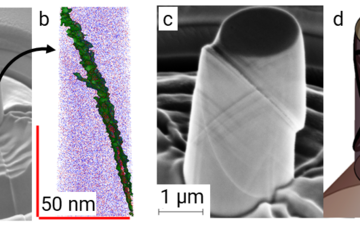All genres
1.
Journal Article
Dislocation plasticity and detwinning under thermal stresses in nanotwinned Ag thin films. Acta Materialia 198, pp. 61 - 71 (2020)
2.
Journal Article
Microcantilever Fracture Testing of Intermetallic Cu3Sn in Lead-Free Solder Interconnects. Journal of Electronic Materials 46 (3), pp. 1607 - 1611 (2017)
3.
Journal Article
Fracture toughness of intermetallic Cu6Sn5 in lead-free solder microelectronics. Scripta Materialia 123, pp. 38 - 41 (2016)
4.
Journal Article
Size and orientation dependent mechanical behavior of body-centered tetragonal Sn at 0.6 of the melting temperature. Acta Materialia 115, pp. 76 - 82 (2016)
5.
Journal Article
Transition from shear to stress-assisted diffusion of copper–chromium nanolayered thin films at elevated temperatures. Acta Materialia 100, pp. 73 - 80 (2015)
6.
Journal Article
Comparing small scale plasticity of copper-chromium nanolayered and alloyed thin films at elevated temperatures. Acta Materialia 93, 12073, pp. 175 - 186 (2015)
7.
Journal Article
Effects of processing on texture, internal stresses and mechanical properties during the pulsed electrodeposition of nanocrystalline and ultrafine-grained nickel. Acta Materialia 61 (11), pp. 3945 - 3955 (2013)
8.
Talk
Slip transmission in nanotwinned Ag under mechanical and thermomechanical loading. Nanobrücken 2020, Düsseldorf, Germany (2020)
9.
Talk
Thermo-mechanical behavior of nanolayered thin films. 9th European Solid Mechanics Conference (ESMC 2015), Leganés-Madrid, Spain (2015)
10.
Talk
Mechanical behavior of nanolayered thin films: Interface control. 3rd General Meeting of the GDRi CNRS "Mechanics of Nano-objects", Empa, Thun, Switzerland (2014)
11.
Talk
Micromechanical investigation of lead-free solder joints in microelectronics. TMS 2014, San Diego, CA, USA (2014)
12.
Talk
Micromechanical testing of lead-free solder joints in microelectronics. Arbeitskreistreffen Rasterkraftmikroskopie und nanomechanische Methoden, MPI für Eisenforschung GmbH, Düsseldorf, Deutschland (2014)
13.
Talk
Micromechanical investigation of solder joints in automotive microelectronics. Euromat 2013, Sevilla, Spanien (2013)
14.
Poster
Improving lead-free solders by resolving mechanical properties at the microstructure length scale. Thin Film & Small Scale Mechanical Behavior 2014, Gordon Research Conference, Waltham, MA, USA (2014)
15.
Poster
Micromechanical investigation of solder joints in automotive microelectronics. GDRi CNRS MECANO General Meeting on the Mechanics of Nano-Objects, MPIE, Düsseldorf, Germany (2013)
16.
Poster
Micromechanical investigation of solder joints for automotive microelectronics. Nano- and Micromechanical Testing in Materials Research and Development IV, Olhão Algarve, Portugal (2013)
17.
Poster
Micromechanical investigation of lead-free solder joints in microelectronics. Small Scale Plasticity School, Cargèse, Korsika, France (2013)
18.
Poster
Thermo-mechanical investigation of lead-free solder. GDRi MECANO General Meeting 2012, Ecole de Mines, Paris, France (2012)
19.
Thesis - PhD
Micromechanical characterization of lead-free solder and its individual microstructure elements. Dissertation, Fakultät für Maschnenbau, RUB, Bochum, Germany (2016)











